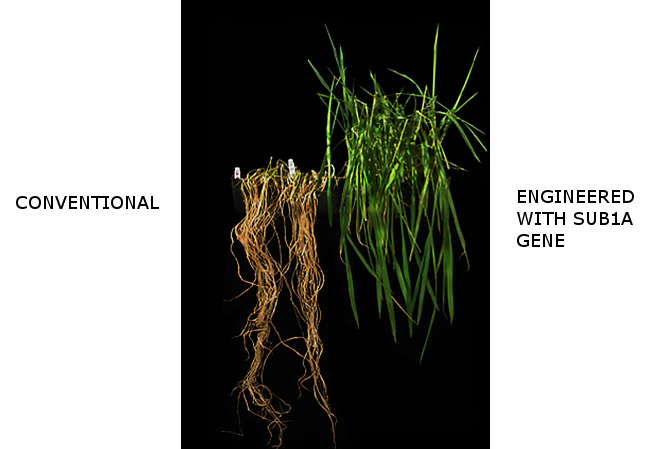
Each year millions of small farmers in the poorest areas of the world lose their entire crops to flooding. Although 24% of the global rice crop is grown in paddies, most rice varieties will die if fully submerged for more than three days. In India and Bangladesh alone, submergence destroys 4 million tons of rice each year, enough to feed 30 million people.
About 50 years ago, breeders discovered an unusual and ancient variety of rice that could withstand 2 weeks of complete submergence. Using conventional approaches, breeders tried to introduce this submergence tolerance trait into rice varieties favored by farmers in India and Bangladesh. However, because the breeding was imprecise, the resulting varieties were rejected by farmers. In the 1990s, rice breeder David Mackill (University of California, Davis) and graduate student Kenong Xu (University of California, Davis) demonstrated that tolerance to complete submergence mapped to the Submergence tolerant 1 (Sub1) Quantitative trait locus (QTL).
In 1996, Ronald began a project with Mackill and Xu, funded by the USDA, to isolate the genes at the Sub1 locus. Over a period of 10 years, Dr. Xu carried out fine mapping and physical isolation of the Sub1 gene in the Mackill and Ronald laboratories at the University of California, Davis (Xu. et. al., 2000). While working as a postdoctoral fellow in Ronald's laboratory, Xu identified and sequenced the Sub1 QTL genomic region, revealed that it carried three ethylene response transcription factors (ERF) and demonstrated that one of the ERFs, designated Sub1A, was up-regulated rapidly in response to submergence. Xu and Ronald further demonstrated that overexpression of Sub1A conferred robust tolerance to submergence in genetically engineered plants (Xu. et. al., 2006). This work revealed an important mechanism with which plants control tolerance to environmental stress and set the stage for in-depth molecular-genetic analyses of Sub1A-mediated processes (Jung et al., 2010).
Sub1 function: Dr. Sigrid Heuer (International Rice Research Institute) further advanced the analysis of genetic variation at the Sub1 locus. As part of a third USDA grant (to Pamela Ronald and Professor Julia Bailey Serres (University of California, Riverside)), postdoctoral fellow Takeshi Fukao was instrumental in advancing mechanistic understanding of Sub1 function (Fukao et al., 2006).
Sub1 breeding: Using the detailed genetic information about the Sub1 locus, Mackill and Abdel Ismail's teams at the International Rice Research Institute (IRRI) generated and released several Sub1A varieties (developed through marker-assisted breeding) in seven countries. In 2017, with support from the Bill and Melinda Gates Foundation, Sub1 rice reached over 6 million farmers.
For more information see:
- Xu K, Ismail A, and Pamela C. Ronald. 2014. "Flood Tolerance in Rice" in "Plant Abiotic Stress 2nd Edition". Wiley-Blackwell Publishing. Matt Jenks and M. Hasegawa, Eds.
- Emerick, Kyle and Pamela C. Ronald. 2019. "Sub1 Rice: Engineering Rice for Climate Change." Cold Spring Harbor Perspectives in Biology. doi: 10.1101/cshperspect.a034637